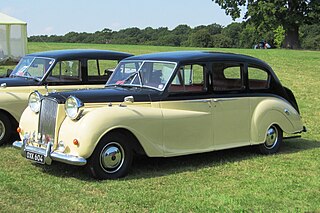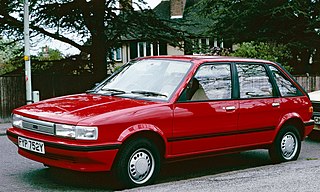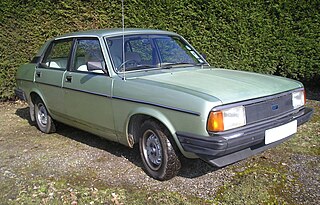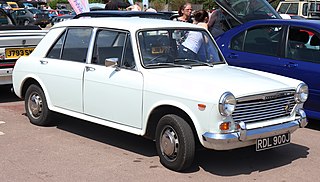
The Morris Marina is a front-engined, rear-wheel-drive small family car that was manufactured by the Austin-Morris division of British Leyland from 1971 until 1980. It served to replace the Morris Minor in the Morris product line, which had first been built in 1948. The Marina was also sold in some markets as the Austin Marina, the Leyland Marina and the Morris 1700.

The Austin Allegro is a small family car that was manufactured by the Austin-Morris division of British Leyland from 1973 until 1982. The same vehicle was built in Italy by Innocenti between 1974 and 1975 and sold as the Innocenti Regent. The Allegro was designed as a replacement for the Austin 1100 and 1300 models. In total, 642,350 Austin Allegros were produced during its ten-year production life, most of which were sold on the home market, less than a third of 2.1 million 1100s and 1300s sold in the previous 11 years.

British Leyland was an automotive engineering and manufacturing conglomerate formed in the United Kingdom in 1968 as British Leyland Motor Corporation Ltd (BLMC), following the merger of Leyland Motors and British Motor Holdings. It was partly nationalised in 1975, when the UK government created a holding company called British Leyland, later renamed BL in 1978. It incorporated much of the British-owned motor vehicle industry, which in 1968 had a 40 percent share of the UK car market, with its history going back to 1895. Despite containing profitable marques such as Jaguar, Rover, and Land Rover, as well as the best-selling Mini, BLMC had a troubled history, leading to its eventual collapse in 1975 and subsequent part-nationalisation.

The Princess is a large family car produced in the United Kingdom by the Austin-Morris division of British Leyland from 1975 until 1981. The car inherited a front-wheel drive / transverse engine configuration from its predecessor, the Austin/Morris 1800 range. This was still unusual in Europe for family cars of this type and gave the Princess a cabin space advantage when compared with similarly sized cars from competing manufacturers.

The Austin Princess is a series of large luxury cars that were made by Austin and its subsidiary Vanden Plas from 1947 to 1968. The cars were also marketed under the Princess and Vanden Plas marque names.

The Metro is a supermini car, later a city car that was produced by British Leyland (BL) and, later, the Rover Group from 1980 to 1998. It was launched in 1980 as the Austin mini Metro. It was intended to complement and eventually replace the Mini, and was developed under the codename LC8. The Metro was named by What Car? magazine as 'Car of The Year' in 1983 as an MG, and again as the Rover Metro in 1991.

The Austin Maestro is a five-door hatchback small family car that was produced from 1982 to 1986 by British Leyland, and from 1986 until 1994 by Rover Group, as a replacement for the Austin Maxi and Austin Allegro, with the van version replacing the corresponding van derivative of the Morris Ital. The car was produced at Morris' former Oxford plant, also known as Cowley, with 605,000 units sold. Today, the redeveloped factory builds the BMW Mini. An MG-branded performance version was sold as the MG Maestro from 1983 until 1991.
The Austin Rover Group was a British motor manufacturer. It was created in 1982 as the mass-market car manufacturing subsidiary of British Leyland (BL). Previously, this entity had been known as BL Cars Ltd which encompassed the Austin-Morris and Jaguar-Rover-Triumph divisions of British Leyland. After a major restructuring of BL's car manufacturing operations, Jaguar regained its independence whilst the Triumph and Morris marques were retired. The new, leaner car business was rechristened as the Austin Rover Group and focused primarily on the Austin and Rover marques. The Morris and Triumph marques continued briefly within ARG until 1984 when both were dropped.

The Austin Montego is a British family car that was produced by British Leyland from 1984 until 1988, and then by Rover Group from 1988 until 1995. The Montego was the replacement for both the rear-wheel drive Morris Ital and the front-wheel drive Austin Ambassador ranges to give British Leyland an all-new competitor for the Ford Sierra and Vauxhall Cavalier.

The Rover V8 engine is a compact V8 internal combustion engine with aluminium cylinder block and cylinder heads, originally designed by General Motors and later re-designed and produced by Rover in the United Kingdom. It has been used in a wide range of vehicles from Rover and other manufacturers since its British debut in 1967.

The Triumph Acclaim is a front-wheel drive compact family saloon/sedan manufactured by British Leyland (BL) from 1981 to 1984. It is based on the Honda Ballade. It used a Honda-designed engine, was manufactured under licence from Honda, and met United Kingdom component-content requirements. It was the final model of the Triumph marque, and the first product of the alliance between BL and Honda which would last until the mid 1990s.

The Morris Ital is a medium-sized car that was built by British Leyland (BL) from 1980 to 1984. A successor to the Morris Marina, it was available in a variety of bodystyles.

The Austin Maxi is a medium-sized, 5-door hatchback family car that was produced by Austin and later British Leyland between 1969 and 1981. It was the first British car to feature a hatchback body style.

The Rover SD1 is both the code name and eventual production name given to a series of executive cars built by the Specialist Division, and finally the Austin Rover division of British Leyland from 1976 until 1986, when it was replaced by the Rover 800. The SD1 was marketed under various names. In 1977 it won the European Car of the Year title.

BMC ADO17 is the model code used by the British Motor Corporation (BMC) for a range of large family cars manufactured from September 1964 to 1975. The car was initially sold under the Austin marque as the Austin 1800, then by Morris as the Morris 1800, by Wolseley as the Wolseley 18/85, and later the Austin 2200, Morris 2200 and Wolseley Six. The 1800 was voted European Car of the Year for 1965.

The BMC ADO16 is a range of small family cars built by the British Motor Corporation (BMC) and, later, British Leyland. Launched in 1962, it was Britain's best-selling car from 1963 to 1966 and from 1968 to 1971. The ADO16 was marketed under various make and model names; however, the Austin 1100 and Morris 1100 were the most prolific of all the ADO16 variants. The car's ubiquity at the height of its popularity led to it simply being known as the 1100 (eleven-hundred) in its home market. Also made with a 1300cc engine, it was then typically called 1300.

The Austin 3-Litre is a British saloon car that was introduced by Austin at the London Motor Show in 1967. Codenamed ADO61, the car was intended to be BMC's offering in the 3-litre executive class and was originally designed in the early 1960s, before the British Leyland era. Unlike the visually similar front-wheel drive Morris 1800 range, the 125 bhp 3-litre engine drove the rear wheels through a conventional 4-speed gearbox.

The BL O-series engine is a straight-4 automobile engine family that was produced by the Austin-Morris division of British Leyland (BL) as a development of the BMC B-series engine family.

The Austin Kimberley and Austin Tasman "X6" models are a pair of Leyland Australia-designed front-wheel-drive sedans based on the Austin 1800 (ADO17) platform, that were produced from 1970 to 1972 and sold by Austin. At the time of the X6 being launched onto the Australian market it was quite an advanced design in comparison to the other competitors from Ford, Holden and Chrysler, whose rear-wheel drive, conventionally sprung underpinnings dominated the market at the time.
The Amalgamated Drawing Office was the design and engineering department of the British Motor Corporation. From the early 1950s, the resulting projects of the office were known by the initials ADO. The numbers were assigned to vehicle and engineering projects, some resulting in production models. The ADO numbering system continued well beyond BMC's absorption into British Leyland, who continued to use the convention until the late 1970s.




















